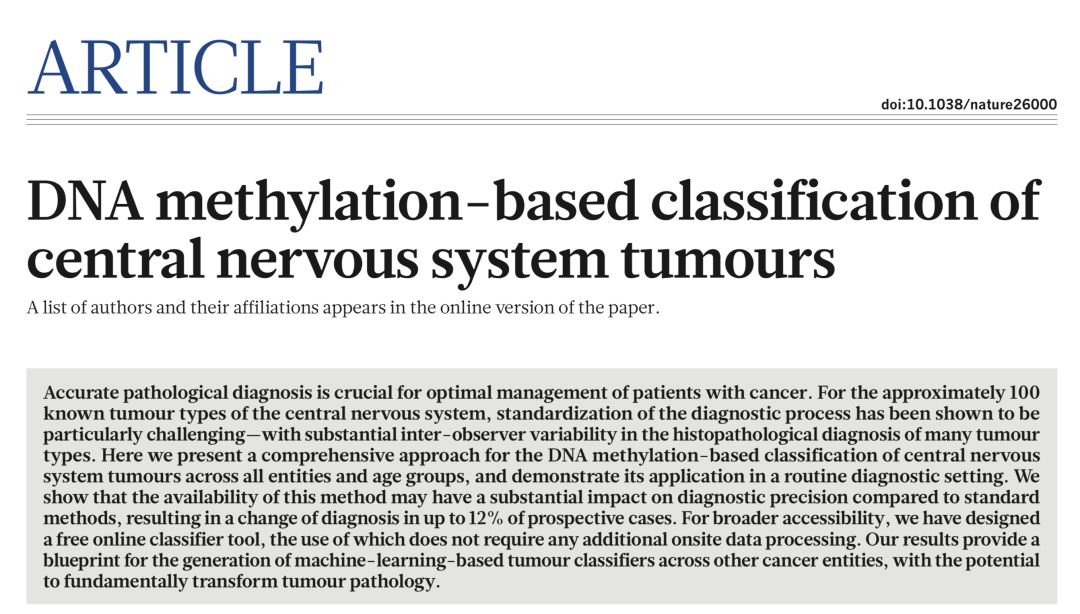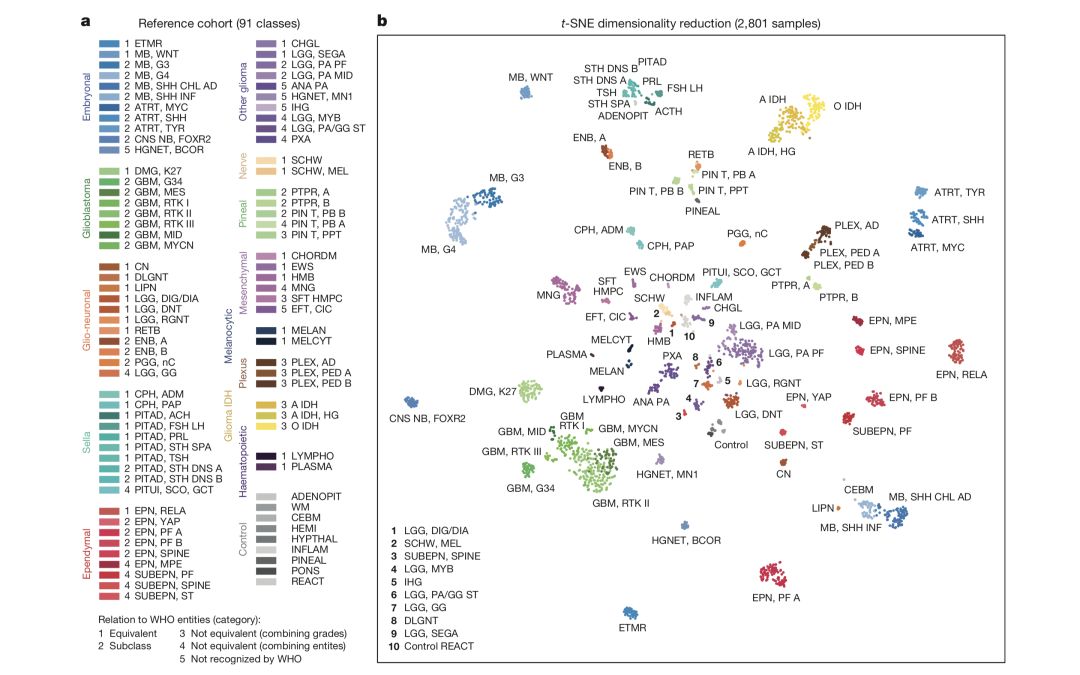Release date: 2018-03-21
This week, artificial intelligence was opened again.
Less than a month before we last reported Professor Zhang Kang’s heavy AI research, nearly 150 scientists from more than 100 laboratories around the world jointly published in the top journal Nature, [1], they developed a super AI system. Based on the methylation data of tumor tissue DNA, it can accurately distinguish nearly 100 different central nervous system tumors. What's more, this AI system can also find new categories that are not available in the guide. This is a huge improvement for the precise treatment of cancer.

On the one hand, this study can make up for the problem that is difficult to diagnose in the current central nervous system tumors, and on the other hand, it has made great contributions to the classification of the central nervous system tumors that are still not perfect.
Among many cancers, central nervous system tumors can be said to be the most difficult. At present, scientists have identified more than 100 kinds of central nervous system tumors [2], their clinical manifestations and biological characteristics are highly specific, difficult to diagnose. Due to the scarcity of molecular markers of such tumors, the core diagnostic technique for clinical central nervous system tumors is still based on histological diagnosis of the microscope.
However, the difficulty is that many tumors that perform similarly under the microscope actually have different genetic variability characteristics, which are almost difficult to observe, which brings great difficulties to accurate diagnosis. Although the FDA has approved techniques for the diagnosis of diseases based on histopathological slice imaging [3], many startups have begun to try to use AI to analyze these pathological images to assist doctors in diagnosis. However, the above problems are still unavoidable.
Therefore, in recent years, WHO has gradually added molecular indicators to the classification criteria, such as several genetic variants and methylation related to specific brain cancer subtypes.
The international team led by Andreas von Deimling and Stefan M. Pfister believes that analyzing the methylation group of cancer is a very smart approach. The methylation feature can mark the corresponding cellular changes on the one hand and can also be used to track the source of cells on the one hand. For example, to diagnose cancers with unknown lesions [4]. Moreover, previous experiments have confirmed the reliability of cancer methylation data, even in small samples can be repeated [5]. What researchers are doing now is to continue to expand on these scattered data, so that the cancer methylation group can become a unified standard, comprehensive diagnostic and classification tool.
But the big question here is where the methylation data comes from. The development of AI systems requires a large number of data training algorithms, but limited to the previous technical deficiencies and high costs, the methylation data for a specific tumor is obviously seriously insufficient, not to mention that this is a center with a particularly high incidence. Nervous system tumors.
Thanks for the advancement of technology. Now scientists can easily extract DNA from formalin-fixed paraffin-embedded tissue (FFPE), which solves the problem of the source of the experimental material. Although there is not enough data on tumor DNA methylation, FFPE samples are kept in many laboratories and medical facilities around the world.
As a result, this large research team began collecting FFPE samples and using Illumina's mainstream methylation chip 450K (analyzed 450,000 methylation sites in the human body) to analyze methylation data of nearly 3,000 tumor samples, covering almost All types of central nervous system tumors in the current WHO classification. In addition, to distinguish between central nervous system tumors and other tumors and normal brain tissue, the team also analyzed partial mesenchymal tumors, melanoma, diffuse large B-cell lymphoma, plasmacytoma, and six pituitary glands. Tumors, as well as DNA methylation in healthy brain tissue.

Decision-making process
The researchers handed over hundreds of thousands of methylation information from each sample to the computer. First, according to the WHO classification and the diagnostic results of the samples, under the supervised machine learning algorithm, the methyl groups of each type of tumor defined by WHO were analyzed. The characteristics were then analyzed again by unsupervised machine learning algorithms, allowing the AI ​​system to summarize its knowledge of central nervous system tumor methylation.
Finally, they obtained the methylation characteristics of 82 central nervous system tumors and the methylation characteristics of 9 control samples. These 91 methylation features are the classification of the central nervous system tumor A by the AI ​​system under the guidance of the WHO definition. Obviously, the classification of central nervous system tumors by the AI ​​system is certainly not completely coincident with the WHO classification.
The researchers divided the 82 methylation features into five categories.
The first 29 categories are completely matched with the WHO classification. That is to say, the AI ​​system considers these methylation features to belong to a certain type of tumor. According to the WHO classification criteria, the doctor's previous diagnosis does belong to this category. There are also 29 in the second category, which match the subtypes under certain tumors in the WHO classification.
The rest is only partially matched, or not matched at all. These are also of great interest to researchers who believe that this discovery can help researchers understand the central nervous system tumors more deeply.

a, 91 methylation features, and the five categories to which they belong; b, 2,801 samples of methylation feature dimensionality reduction data
At this point, the methylation characteristics of central nervous system tumors have been extracted by the AI ​​system, plus a control group, a total of 91. Obviously, if the research ends here, the value of use is still limited. After all, manually analyzing the methylation type of each sample with these 91 matches is a very time consuming and laborious task.
So, they handed the 91 methylation types to the random forest machine learning algorithm and developed an AI decision system. As long as the researchers imported the methylation data from the sequencing machine into the AI ​​system, they can quickly judge. Which kind of tumor does this belong to?
To verify the accuracy of these methylation features and AI decision systems. The investigators selected 1104 tissue samples from patients with central nervous system tumors that had been diagnosed by histology and molecular biology, using traditional standard histopathological analysis and the AI ​​system for diagnosis.
As a result, the AI ​​system and pathologist diagnosis were consistent on 60.4% of the samples. 15.5% of the sample AI systems and pathologists are also consistent, except that the AI ​​system believes that they should belong to a smaller subtype.
In 12.6% of cases, the results of the AI ​​system and pathologist diagnosis were inconsistent. Is that the right AI system, or is it a pathologist? So the researchers made a more in-depth analysis of this part of the sample (such as gene sequencing), and finally found that 92.8% of the samples were AI system pairs.
The last remaining 11.5% of the samples, the AI ​​system said that there is nothing to do, do not know how to classify, careful analysis found that one-third of them are rare tumors, may be insufficient sample size in the early stage, leading to AI system can not be identified. Therefore, this part may be solved with the accumulation of data.

Case identification of AI system
At present, the AI ​​platform has been opened to research institutions free of charge [6]. Since its launch in 2016, nearly 10,000 individual DNA methylation data has been uploaded! Practicality has been supported by more than a thousand real cases.
Of course, the researchers also suggested that methylation features are not yet a single diagnostic criterion and require clinical validation. However, as a research tool, it will make a major step forward in the research of central nervous system tumors.
On the one hand, uniform, easy-to-use standards will make research more organized; on the other hand, the clear data characteristics of the methylation group are also easy to use for computer analysis. With this technology, our classification of tumors will be more dynamic and gradually improved, eventually leading to more precise and targeted treatment options.
Reference materials:
[1]. David Capper, David TW Jones, Martin Sill, et al. DNA methylation-based classification of central nervous system tumours. Nature, 2018.
[2]. Louis DN, Perry A, Reifenberger G, et al. The 2016 World Health Organization classification of tumors of the central nervous system: a summary[J]. Acta neuropathologica, 2016, 131(6): 803-820.
[3]. https://
[4]. Moran, S. et al. Epigenetic profling to classify cancer of unknown primary: a multicentre, retrospective analysis. Lancet Oncol. 17, 1386–1395 (2016).
[5] Hovestadt, V. et al. Robust molecular subgrouping and copy-number profling of medulloblastoma from small amounts of archival tumour material using high-density DNA methylation arrays. Acta Neuropathol. 125, 913–916 (2013).
[6] https://
Source: Singularity Network
Multiplex RT-PCR Test Reagent Kit Of COVID-19(ORF1ab)/Influenza A/Influenza B
The Multiplex RT-PCR Test Reagent Kit Of COVID-19(ORF1ab)/Influenza A/Influenza B is a real-time reverse-transcription polymerase chain reaction (RT-PCR) test reagent that detects and differentiates RNA from SARS-CoV-2, influenza A virus, and influenza B virus in upper or lower respiratory specimens. The assay provides a sensitive, nucleic-acid-based diagnostic tool for evaluation of specimens from patients in the acute phase of infection.
Multiplex RT-PCR test reagent kit,Multiplex RT-PCR test reagent,Multiplex RT-PCR test kit,Multiplex real time PCR test reagent,Multiplex real-time PCR test reagent
Shenzhen Uni-medica Technology Co.,Ltd , https://www.unimed-global.com